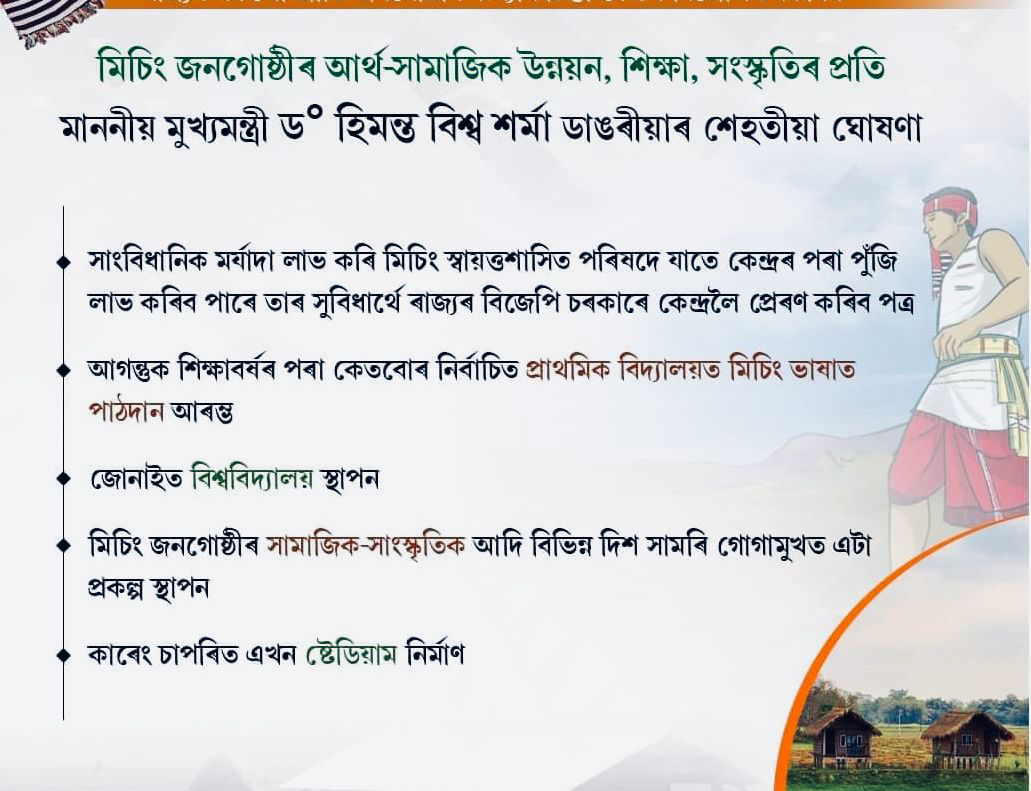LOTTA
An Open Space
Sunday, October 6, 2024
Why Mising Autonomous Council is in the news again?
Thursday, April 11, 2024
Thursday, December 14, 2023
Talks with state government on Mising issues by TMPK, MMK, TMMK
Monday, June 26, 2023
Draft Delimitation, 2023 of Assam: Mising and other tribes may become politicaly insignificant in days to come
Tuesday, May 30, 2023
Mising language in primary schools: But when?
Thursday, November 10, 2022
Monday, May 9, 2022
What is ailing the Mising language?
Sunday, October 24, 2021
Jonai dok tribal belt éla block mopen namdé kémo lo:pé ní:líknammé
Monday, March 15, 2021
End of road or era of new beginning in Mising ethnic politics?
The need of addressing the fundamental Mising aspirations
Majority of the Mising public are in the dark about the terms and conditions of the sudden shift. As the key issues of Mising aspirations are not yet addressed, there are concerns of loss of cultural identity and potential threats to language, customs, tradition and resources in the absence of independent political assertion.
The talk of granting constitutional status to tribal autonomous councils including that of Mising Autonomous Council of Assam at the peak of anti-Citizenship Amendment Act movement is nowhere to be seen in the political theatre now. The big dream of achieving Sixth Schedule under the Indian Constitution today is gradually dying down. Of course, it is claimed that the current phase of political alignment is part of the process of ethnic movement itself.
Flood and erosion are one of the prior concerns of the Misings. This perennial problem has triggered displacement and conflict in various parts of upper Assam districts. Natural disaster based internal displacement should get priority in resettlement and rehabilitation agenda. It is compounded by conservation based displacement and worries of eviction from their traditional habitat. In the name of wildlife conservation and expansion of protected areas especially the Kaziranga National Park, it is observed that Mising people of Gohpur and Bokakhat are one of the foremost sufferers. There is need of reviewing the current conservation approach followed by the government that constantly keep indigenous people and forest dwellers under threat of eviction and forceful relocation. There are also demands for Poba reserved forest of Jonai in Assam-Arunachal border should be declared as protected areas. However, from the evergrowing experiences encountered by the people, all these matters need to be carried forward to environment and conservation policymakers of the country . The grievances must find solution. People and conservation must co-exist, they should not be mutually excluded.
In the cultural front, the demand of state holiday on Ali-aye Lígang could not be realized even after years of movement. In the context of development of language, the issue of medium of instruction in mother tongue in Mising inhabited areas in primary schools are not yet addressed. The New Education Policy, 2020 has been welcomed by Mising organizations as it automatically stressed on providing education in mother tongue in primary level. However, given the scenario of language politics prevailing in the state of Assam, the introduction of such language policies will face challenges. Key Mising inhabited area lacks a full-fledged university or a medical college. A proposed campus of Tezpur University which was to be set up in Jonai did not see the light of the day even after years of donation of land by local people. While rehabilitation and land crises are on the rise among the Misings, the Dibru-Saikhowa National Park residents are yet to be fully addressed. Vast majority of people does not own land entitlement certificates. Forest land inhabited by Misings should be dereserved and be accorded as habitat tag.
In the southern bank of Brahmaputra river, the riverine belt from Kaziranga National Park to Bogibeel bridge communities live in pathetic condition in terms of road and communication. Majority of the Mising inhabited river bank areas live a challenging life in monsoon season in districts like Jorhat, Sivasagar and Golaghat. There is a need of attention from policy makers to improve the infrastructure along the river bank to ameliorate the miserable conditions. Raised platforms for cattle are required more in the region. Embankment built in the river bank should be transformed into a highway for better communication in order to address the communication bottleneck beginning from Kaziranga area of Bokakhat to Bogibeel bridge after proper scientific study.
Will national parties be committed to Mising aspiration?
The fundamental aspects of Mising aspirations must be addressed at first while the quest for power and influence might continue like any other politicized ethnic groups. Otherwise, the remnant of ethnic mobilization will not decompose easily even after capturing power in the future. It will, of course, satisfy a section of clietilistic network of followers but collective benefits in the form of public goods cannot be accrued for the community at large. This assembly elections of 2021, for Misings, is nevertheless a new beginning in political participation of the Mising nationalist path. However, common Mising public will wait and watch whether the national parties honour with commitment to the fundamental aspirations of Mising tribe.
Saturday, December 21, 2019
What is the Constitutional status for Misings and other tribal councils of Assam?
Why Mising Autonomous Council is in the news again?
The publications of draft delimitation of constituencies in Mising Autonomous Council in Dhemaji district of Assam have invited sharp reacti...

-
There are basically two postulates on the origin of Pagro sub-group of Mising tribe.The debates revolves round the stalwarts o...





















